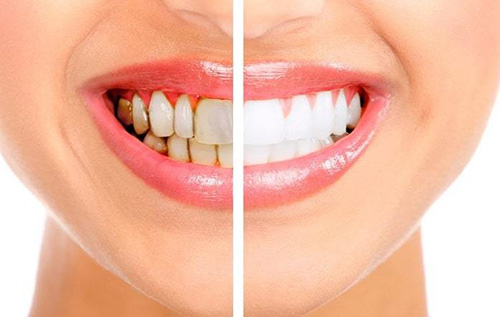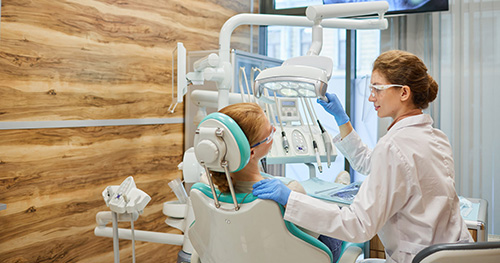
Although everyone wants the Hollywood smile, only a handful of people are blessed with naturally bright white teeth. There are many things like your food habits (coffee, tea, soda, etc.)) and your lifestyle (smoking) that cause tooth's yellowing. If you've been looking to eliminate the unattractive shade and stain that has accumulated in your smile, then you've found the right spot!
The process of reducing the tooth's shade through a chemical agent that helps alter the organic pigmentation of the tooth is known as Bleaching. The bleaching process is thought of as the best safe, secure, and effective method and the least surgical method of overcoming dental discolouration both inside and outside to change the aesthetics of teeth. The benefit of bleaching teeth is in the manner that ensures the dental structure remain intact. Furthermore, thanks to the development of new bleaching agents, Bleaching is fast and secure.
Bleaching procedures few techniques in dentistry can be as widely used in whitening teeth as teeth. The main reasons for teeth whitening stem from direct patients' desire to whiten their teeth or other restorative procedures involving an openly visible smile. There are some warnings against it; extra care should be taken in the case of sensitivity, in children or pregnancies. Tooth sensitivity could be a cause for concern. Techniques for Bleaching can be classified based on whether they are performed on important or not vital teeth and whether the procedure occurs at either the dental clinic or out of the clinic.
In-Office Bleaching of vital teeth is possible through an at-home method, dental supervision bleaching, or self-bleaching with over-the-counter products. In-office bleaching hydrogen peroxide (concentrations varying between 15 per cent to 38 per cent) is applied directly to the surface of the tooth. To speed up the process of Bleaching, the bleaching agent could have to be "photo" activated using light-emitting diodes (LED) plasma arcs and quartz halogens ultraviolet units, as well as lasers. It is referred to by the term "power bleaching". The use of this method results in a shorter treatment time and a decrease in the negative effects of bleaching substances. LED treatments are typically performed over three to four times every seven days.
Home Bleaching Professionally prescribed home bleaching agents have proven effective in whitening discoloured teeth. The process of Bleaching at home is monitored closely through the eyes of the dentist, thus making sure that they are safe and increasing the efficacy of the procedure. The "home vital bleaching" procedure typically uses carbamide peroxide in concentrations of between 10 and 16 per cent; this is the lowest level of hydrogen peroxide. However, it is applied for a longer duration than in-office Bleaching, which is applied to individual trays used during the night (nightguard) using an average of four hours for application and over the day, over up to five weeks.
This technique was a reliable treatment option for bleaching teeth; however, whitening restricted its application to the endodontically treated tooth. 35% to 30% hydrogen peroxide and sodium perborate, either together or in isolation, are the most frequently utilized bleaching agents to prevent the vitality of the teeth treated by endodontics that causes oxidation reaction and the degradation of pigment molecules is the result. Are our teeth whitening products secure? Teeth whitening is healthy for your teeth, and it doesn't harm the enamel. The main ingredient of action is hydrogen peroxide, which is broken down into oxygen, eliminating staining and making your teeth appear whiter while keeping the structure of your teeth unaltered.
Our clinic can do whitening teeth in a single session. Gums are separated, and a bleaching gel is applied to the tooth's surface. Based on the shape of tooth tissue and the hue of the tooth, the doctor decides if he wants to utilize lasers or LED, or halogen or LED for activating the gel.

The whole in-office teeth whitening procedure can last up to 40 minutes. We'll perform the necessary preparations to protect your gums and then apply the application of the gel for whitening. A special light or lamp could be used or not. Most of our patients stream Netflix or listen to music as they're having their teeth whitened. Others even sleep through the procedure.
The effects can last for various durations based on your lifestyle and oral hygiene habits; however, generally speaking, they can last up to a whole year. Regularly reapplying your treatments every three to six months (or as directed by your doctor) will ensure an attractive sheen, particularly when you smoke, drink tea or coffee.
Cleaning your newly whitened teeth is simple! Maintain a healthy oral hygiene routine. Brush your teeth two times every day and floss every day with fluoride toothpaste. Have your teeth cleaned at least every six months or as your dentist dental hygienist advised. To ensure the whiteness that your teeth have, stay clear of dark and acidic foods and drinks like coffee, torn wine and sports drinks. Also, avoid carbonated beverages and sauces such as tomato curry, soy and.
If there's one tooth with a much darker shade than teeth, it is a sign that it has lost its vitality or was subjected to an operation to treat the root canal. In this instance, the whitening solution is sprayed by a dentist to the tooth. It is then replaced every two or three days until the desired colour is reached. It typically takes about a week, and the results are stunning. The new whiter shade typically lasts for a longer duration of time.
Please send us email to get further information and get pricing.
